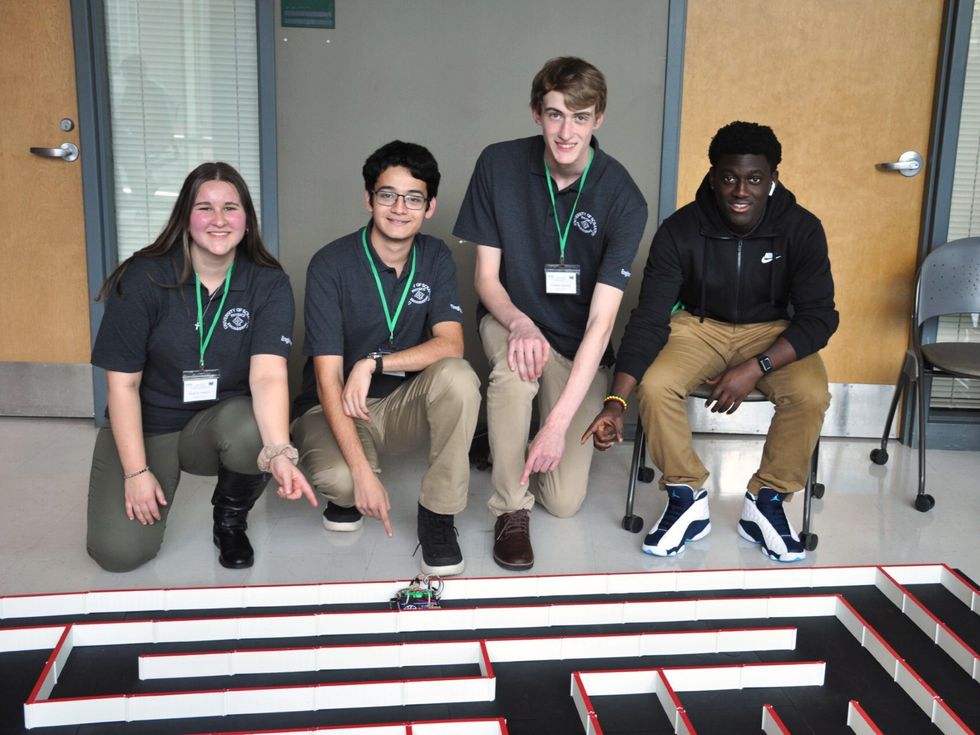[ad_1]
Many faculty college students take part in sports activities, hearken to music, or play video video games of their spare time, however IEEE Pupil Member Gerard Piccini prefers beginner radio, often known as ham radio. He’s been concerned with the two-way radio communication, which makes use of designated frequencies, since his uncle launched him to it when he was a teen. His name signal is KD2ZHK.
Piccini, from Monroe Township, N.J., is pursuing {an electrical} engineering diploma on the College of Scranton, in Pennsylvania. The junior is president of the college’s W3USR beginner radio membership. He’s additionally a member of Scranton’s IEEE pupil department, the IEEE Membership.
Gerard Piccini
Member grade
Pupil member; member of IEEE-HKN’s Lambda Nu chapter
College:
College of Scranton in Pennsylvania
Main:
Electrical engineering
Minors:
Math and physics
Grade:
Junior
One other of his passions is robotics. He captained one of many college membership’s groups that participated within the Micro Mouse competitors held in the course of the October IEEE Area 2 Pupil Actions Convention, hosted by Marshall College in Huntington, W.Va. The Scranton workforce competed towards different pupil branches to construct and program small robots to navigate a maze within the shortest time potential. The workforce positioned second.
“The competition was an incredible alternative for me,” Piccini says, “to learn to apply the talents I’ve been studying from courses right into a mission that I designed myself.”
Piccini joined Scranton’s beginner radio membership when he was a freshman. Overseeing the membership is IEEE Member Nathaniel Frissell, who has taught Piccini physics and electrical engineering. Frissell seen Piccini’s curiosity in radio expertise and requested the coed to help him with analysis. Piccini now could be serving to to develop a low-cost, low-power system to ship a sign into the ionosphere and measure the time it takes to return.
“The system will permit us to gather extra knowledge concerning the ionosphere, which is an ionized layer of the ambiance and is essential for radio propagation,” he says. “Proper now there are usually not that many full-sized ionospheric sounding programs. If we are able to make them low cost sufficient, we may get ham radio operators to set them up and enhance knowledge factors.”
“I prefer it when I’ve a mission and need to attempt to discover a answer by myself.”
Piccini is lively with Ham Radio Science Citizen Investigation, which incorporates beginner radio fanatics {and professional} scientists who collaborate on analysis.
“The concept behind HamSCI is getting residents concerned in science,” Piccini says.
His analysis, he says, has led him to contemplate a profession in RF engineering or digital sign processing, both in academia or trade.
A born problem-solver
Like different budding engineers, Piccini has loved taking issues aside and determining how you can put them again collectively once more since his youth. Neither of his mother and father was an engineer, however they inspired his curiosity by shopping for him engineering kits.
A highschool physics class impressed him to review electrical engineering. It coated circuits and wave mechanics, a department of quantum physics through which the conduct of objects is described when it comes to their wavelike properties.
He initially was undecided about whether or not to pursue a level in physics or engineering. It wasn’t till he discovered how you can code and work with {hardware} that he selected engineering. And though he nonetheless enjoys coding, he says he’s glad he in the end selected electrical engineering: “I prefer it when I’ve a mission and need to attempt to discover a answer by myself.” He’s minoring in arithmetic and physics.
 Pupil Member Gerard N. Piccini [second from left] with teammates from the IEEE Membership Pupil Department who competed within the IEEE Area 2 Micro Mouse contest. Gabrina Garangmau
Pupil Member Gerard N. Piccini [second from left] with teammates from the IEEE Membership Pupil Department who competed within the IEEE Area 2 Micro Mouse contest. Gabrina Garangmau
An IEEE pupil chief
Piccini says he joined IEEE as a result of he felt “trapped in a bubble of academia.” As an underclassman, he remembers, he didn’t actually know what was occurring within the subject of engineering or in trade.
“Being concerned with IEEE helps offer you that publicity,” he says.
He’s a member of the Lambda Nu chapter of IEEE’s honor society, IEEE-Eta Kappa Nu.
Scranton’s IEEE Membership affords shows by engineering firms and technical talks. The membership additionally encourages college students to elucidate the work they’ve completed throughout their internships.
To present members skilled boosts, the membership holds résumé-writing classes, conducts mock interviews, and has the scholars follow their public-speaking expertise.
The department additionally encourages its members to get entangled with neighborhood initiatives.
Piccini is secretary of the coed department. The place has given him management expertise, he says, together with instructing him how you can arrange and run conferences and coordinate occasions—expertise he wouldn’t have picked up in his courses.
As captain of the Micro Mouse workforce, he was accountable for mentoring youthful college students, overseeing the design of the robotic, and setting the agenda so the workforce would meet the competitors’s deadlines.
He notes that the IEEE Pupil Actions Convention is an effective way to satisfy fellow college students from across the area.
Being lively in IEEE, he says, is “an incredible alternative to community, meet folks, and study new expertise that you just may not have—or have already got however need to develop additional.”
[ad_2]

